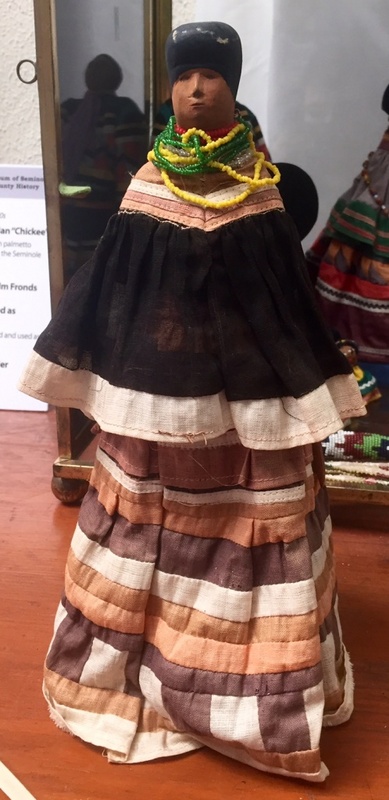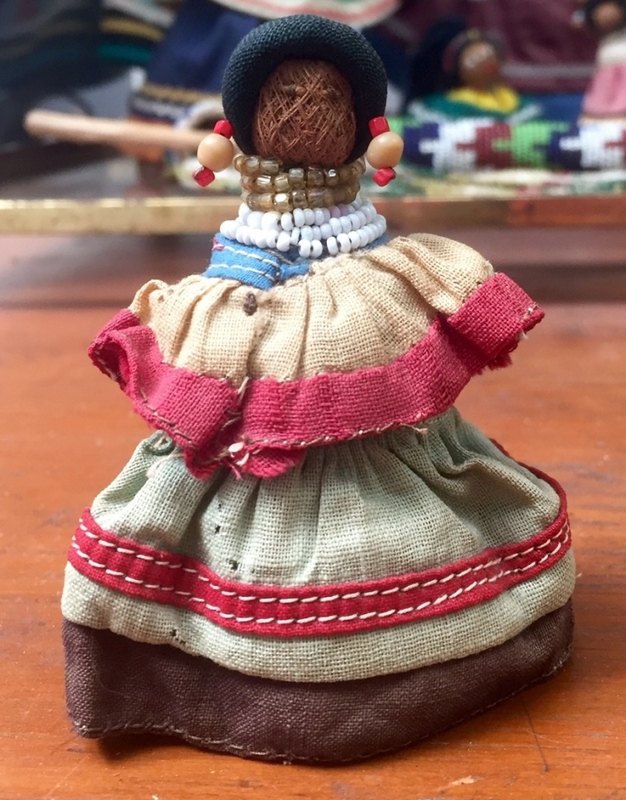Seminole Dolls
Dublin Core
Title
Seminole Dolls
Alternative Title
Seminole Dolls
Subject
Seminole Indians--Florida
Native Americans
Amerindians
Indigenous peoples--United States
Dolls--United States
Art--Florida
Patchwork--United States
Description
Dolls in patchwork clothing created by members of the Seminole tribe in the 1940s. By the end of the 19th century, the few indigenous people remaining in South Florida after the Seminole Wars lived in isolated camps in the wilderness of the Everglades area known as Big Cypress Swamp. Their encounters with white settlers and traders introduced them to hand-cranked sewing machines and other goods. With these new sewing machines, different designs were sewn out of brightly colored cotton fabric pieces in a style that came to be known as patchwork. The designs were intricately made and were inspired by animals and elements of their natural environment.
In 1917, Alice Osceola, the wife of William McKinley Osceola, became the first known woman to wear patchwork adornment on her clothing. As more women took up the practice, the clothing became more elaborate and colorful. Indigenous women made patchwork articles to sell to tourists visiting their camps and settlements. Patchwork clothing and goods became a hallmark of the tribes' handicrafts and sales of these items helped support many Seminole and Miccosukee families before the arrival of the gaming industry. Seminole seamstresses made these dolls out of red palmetto fibers and dressed them in patchwork-style clothing like that of the tribe's women. The dolls are highly prized today by collectors of Seminole Indian artifacts. These specific dolls date to the 1940s and were donated to the Museum of Seminole County History by Clarabel Van Tuyl.
In 1917, Alice Osceola, the wife of William McKinley Osceola, became the first known woman to wear patchwork adornment on her clothing. As more women took up the practice, the clothing became more elaborate and colorful. Indigenous women made patchwork articles to sell to tourists visiting their camps and settlements. Patchwork clothing and goods became a hallmark of the tribes' handicrafts and sales of these items helped support many Seminole and Miccosukee families before the arrival of the gaming industry. Seminole seamstresses made these dolls out of red palmetto fibers and dressed them in patchwork-style clothing like that of the tribe's women. The dolls are highly prized today by collectors of Seminole Indian artifacts. These specific dolls date to the 1940s and were donated to the Museum of Seminole County History by Clarabel Van Tuyl.
Source
Original color digital image, 2015: Museum of Seminole County History, Sanford, Florida.
Date Created
2015
Is Part Of
Museum of Seminole County History, Sanford, Florida.
Seminole County Collection, RICHES of Central Florida.
Format
image/jpg
Extent
124 KB
Medium
10 patchwork dolls
Type
Physical Object
Coverage
Seminole County, Florida
Accrual Method
Donation
Mediator
History Teacher
Humanities Teacher
Visual Arts Teacher
Provenance
Donated to the Museum of Seminole County History by Clarabel Van Tuyl.
Rights Holder
Copyright to this resource is held by the Museum of Seminole County History and is provided here by RICHES of Central Florida for educational purposes only.
Curator
Fried, Aaron
Cepero, Laura
Digital Collection
Source Repository
External Reference
Downs, Dorothy. Patchwork: Seminole and Miccosukee Art and Activities. Sarasota, Fla: Pineapple Press, 2005.
Still Image Item Type Metadata
Original Format
3 color digital images
Collection
Citation
“Seminole Dolls,” RICHES, accessed December 23, 2025, https://richesmi.cah.ucf.edu/omeka/items/show/5614.


